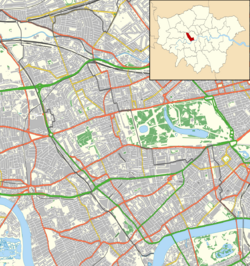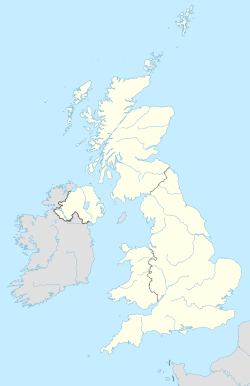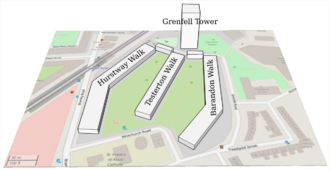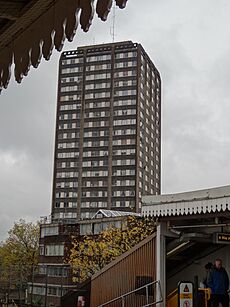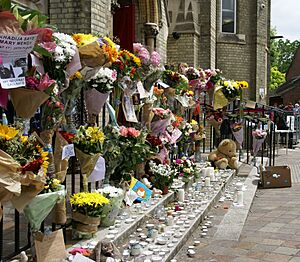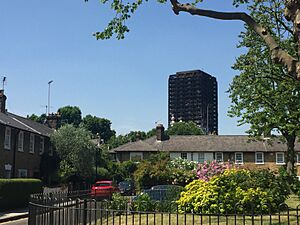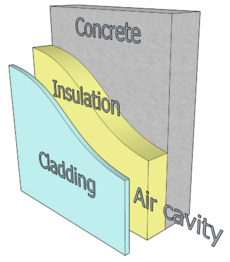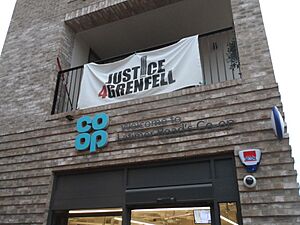Grenfell Tower fire facts for kids
Quick facts for kids 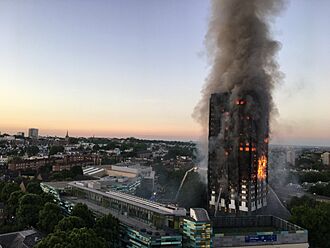
The fire during the early morning hours of 14 June 2017
|
|
| Date | 14 June 2017 |
|---|---|
| Time | 00:54 BST (first emergency call) |
| Duration | 24 hours (under control) Over 60 hours (fully extinguished) |
| Location | Grenfell Tower, North Kensington, London, United Kingdom |
| Type | Structure fire |
| Cause | Electrical fault in a refrigerator; spread of fire largely exacerbated by flammable exterior cladding on the building |
| Outcome |
|
| Deaths | 72 |
| Non-fatal injuries | 74 (20 serious) |
| Property damage | £200 million – £1 billion (estimated) |
| Inquiries | Public inquiry hearings opened 14 September 2017. Final report published 4 September 2024. |
| Inquest | Open for all 72 victims; pending police investigation. |
On 14 June 2017, a huge fire broke out in Grenfell Tower. This was a 24-storey block of flats in North Kensington, West London. The fire started at 00:54 BST and burned for over 60 hours.
Tragically, 72 people died because of the fire. More than 70 people were also injured. About 223 people managed to escape the building safely. This fire was the deadliest structural fire in the United Kingdom since 1988. It was also the worst residential fire in the UK since the Blitz during World War II.
The fire began due to an electrical fault in a refrigerator on the fourth floor. The fire spread quickly because of the building's outer walls. These walls had flammable cladding panels and insulation. Gaps around the windows and poorly installed fire barriers also helped the fire spread fast.
More than 250 London Fire Brigade firefighters and 70 fire engines worked to control the blaze. Over 100 London Ambulance Service crews and specialist paramedics also helped. The Metropolitan Police and London's Air Ambulance assisted in the rescue efforts.
After the fire, several investigations began. These looked into how the building was managed and how the fire services responded. They also examined the building materials used. The leader, deputy leader, and chief executive of the local council later resigned. The council took back control of its housing.
Understanding Grenfell Tower
Building and its Design
Grenfell Tower was part of the Lancaster West Estate. This was a complex of council housing in North Kensington. The 24-storey tower was designed in 1967. Its construction took place from 1972 to 1974.
The building was about 67 metres (220 feet) tall. It had 120 flats, later increased to 129. Up to 600 people could live there. The tower was built to be very strong. This was after the 1968 Ronan Point disaster.
Grenfell Tower was designed with a "stay put policy" for fires. This meant that if a fire started in one flat, thick walls and fire doors would contain it. Only people in the affected flat were expected to leave. The building had only one main staircase. There was no central fire alarm system.
How the Building was Managed
The local council, Kensington and Chelsea London Borough Council, used to manage its housing directly. In 1996, they created a group called Kensington and Chelsea TMO (KCTMO). This group managed the council's housing, including Grenfell Tower. Some flats in the tower had been bought by residents. These were either lived in by the owners or rented out.
Recent Changes to the Tower
Grenfell Tower had a big renovation between 2015 and 2016. New windows were installed. A new heating system was added. The building also got new aluminium composite cladding. This cladding was meant to make the building look better and save energy.
Two types of cladding were used. One was Reynobond PE. It had a polyethylene core. The other was Reynolux aluminium sheets. Underneath these, polyisocyanurate (PIR) insulation was fixed to the walls. A more fire-resistant cladding option was not chosen due to its higher cost.
The company that did the renovation was Rydon. They won the contract because their price was lower. The cladding was put on by Harley Facades.
Safety Concerns Before the Fire
Residents had serious safety worries before the fire. A report 12 years earlier had already criticized the tower's emergency lighting. The Grenfell Action Group (GAG) used a blog to warn about major safety problems. They said the council and KCTMO ignored fire safety.
In 2013, GAG shared a fire risk assessment. It showed that Firefighting equipment had not been checked for years. Some fire extinguishers were expired. GAG tried to contact KCTMO management and the council. They said they never got a reply.
In January 2016, GAG warned that people could get trapped in a fire. They noted the building had only one entrance and exit. Corridors were often full of rubbish. In November 2016, GAG warned that "only a catastrophic event" would show how badly KCTMO was managing things. They said KCTMO could not claim they had not been warned.
In June 2016, an expert found 40 serious fire safety issues. They recommended quick action. In November 2016, the London Fire and Emergency Planning Authority issued a notice. It listed many fire safety problems that KCTMO needed to fix by May 2017. These included fire doors and the smoke venting system.
Past Cladding Fires
Fires involving cladding materials had happened before. In 1973, the Summerland disaster killed 50 people. Acrylic sheeting on the building's outside helped the fire spread. In 1991, the Knowsley Heights fire spread up an 11-storey building due to cladding. In 2009, external panels also played a role in the Lakanal House fire.
The Guardian newspaper called the Grenfell Tower fire a "tragedy foretold." They pointed to previous cladding fires, like one in Dubai in 2015. In 2016, a fire in a Shepherd's Bush tower block spread across six floors because of flammable cladding. In May 2017, the London Fire Brigade (LFB) warned all London councils. They told them to check their buildings for similar panels and fix any risks.
Impact of the Fire
Lives Lost
The fire caused 72 deaths. This included many children. Five of them were students at a nearby school. Most of those who died were in flats on the 11th to 23rd floors. Some people from lower floors may have tried to move higher up the building.
Financial Impact
The direct costs of the fire were very high. In 2023, estimates put the total cost at almost £1.2 billion. Most of this money was paid by the government. This included re-housing survivors and managing the site. It also covered the public inquiry and police investigation.
This huge cost is about 4,000 times more than the £293,368 saved. This saving was made by using cheaper, combustible cladding instead of fire-safe materials.
Aftermath of the Fire
The fire destroyed 151 homes in the tower and nearby areas. People from surrounding buildings were moved out. This was because there were worries the tower might fall.
The fire also affected three smaller buildings next to Grenfell Tower. Their residents had to leave. These buildings also lost hot water because they shared a boiler under Grenfell Tower that was destroyed.
What Caused the Fire to Spread?
The Refrigerator
The fire started because of a faulty fridge-freezer in Flat 16. The model was a Hotpoint FF175BP. Owners of this model were told to register their appliance. This was so they could get updates. About 64,000 of these models were made between 2006 and 2009.
Experts looked at the fridge-freezer. They said its design met all safety rules at the time. So, there was no need to recall the model. However, a consumer group said the safety rules were not good enough.
Tenants had often complained about power surges. These surges sometimes made appliances smoke. The local council knew about these complaints. They had paid residents for damaged appliances. But the surges continued.
Later, an engineer suggested a wire in the fridge-freezer was not connected tightly enough. This poor connection could have caused overheating. This might have set the wire's plastic insulation on fire.
Outer Cladding and Insulation
The new outer walls of the tower played a big role in the fire's spread. They included:
- Outer cladding: aluminium panels with a polyethylene core.
- A gap for ventilation between the cladding and insulation.
- Insulation made of PIR foam plates.
- The original concrete walls.
- New double-glazed windows.
Both the aluminium-polyethylene cladding and the PIR insulation failed fire safety tests after the fire. Experts had warned in 2014 that the insulation was only safe with non-combustible cladding. But combustible panels were used. These panels had a polyethylene core. The insulation, Celotex RS5000, burns when heated. It also gives off toxic cyanide fumes.
The Royal Borough of Kensington and Chelsea council said the building work met "relevant provisions." Council inspectors visited the site 16 times. The combustible materials used were much cheaper than fire-safe ones. There was pressure to save money on the renovation.
Aluminium-Polyethylene Cladding
Fire safety experts believe the new external cladding caused the fire to spread so fast. The gap between the cladding and the insulation acted like a chimney. This helped the fire move quickly. Residents saw the cladding burning and melting. One resident said, "The whole one side of the building was on fire. The cladding went up like a matchstick."
The cladding used was called Reynobond PE. It had a polyethylene core. This type of cladding was only meant for buildings 10 metres (30 feet) or less tall. For taller buildings, a non-combustible version was supposed to be used. After the fire, the company that made Reynobond PE stopped selling it for tower blocks worldwide.
Similar cladding with flammable insulation has been used on thousands of other tall buildings. These are in countries like Britain, France, and Australia. UK rules say that for buildings over 18 metres (59 feet), the whole cladding system must be tested for fire safety.
In June 2017, Chancellor of the Exchequer Philip Hammond said the cladding used on Grenfell Tower was banned in the UK. Yet, inspections during the renovation did not notice this. The Department for Communities and Local Government later confirmed that cladding with a polyethylene core does not meet current building rules for tall buildings.
In the US, the polyethylene version of this material is banned for buildings over 40 feet (12 metres) tall. This is because of the risk of fire spreading. US rules require strict fire tests for external walls on high-rise buildings. The UK did not require such realistic tests.
Polyisocyanurate Insulation
The renovation also used an insulation foam called Celotex RS5000. This was installed behind the cladding. Police said this insulation was "more flammable than the cladding."
This PIR product "will burn if exposed to a fire of sufficient heat and intensity." When it burns, it produces intense heat, thick smoke, and toxic gases. These gases include carbon monoxide and hydrogen cyanide. At least three survivors were treated for cyanide poisoning.
The manufacturer's guide for Celotex RS5000 said it met fire safety standards only under specific conditions. These included using non-combustible panels and fire breaks. Any changes from these conditions needed to be checked by the building designer.
Cavity Barriers and Windows
It was also suggested that fire barriers in the gap between the outer wall and the building were too small or wrongly installed. These barriers are meant to stop fire from spreading. Their failure helped the fire move quickly.
New windows and their frames were also thought to be less fire resistant than the old ones. This could have allowed fire to spread between the inside and outside of the building more easily.
Fire Safety Checks and Changes
In the United Kingdom

After the fire, local councils across the UK checked fire safety in their tall residential buildings. Building rules were also reviewed.
An independent review of building rules and fire safety began in August 2017. It was led by Dame Judith Hackitt. Her job was to improve building rules for tall residential blocks. She also aimed to reassure residents that their homes were safe.
In December 2017, Hackitt said the whole building safety system was "not fit for purpose." Her final report in May 2018 found many problems. It did not ban combustible cladding. But the government is now thinking about banning flammable materials.
In October 2018, the government planned to ban flammable cladding on new buildings over 18 metres (59 feet). This also included schools and care homes. The Fire Brigades Union wants a complete ban on all buildings.
By November 2019, the government found 446 buildings with similar cladding to Grenfell Tower. They pledged £600 million to fix these. But many more buildings were found to have safety problems. By June 2020, about 2,000 high-risk buildings were identified. The government has pledged over £5 billion to fix fire safety issues.
In June 2020, another London tower block, "Ferrier Point," had a fire. It had the same cladding as Grenfell, but it was removed a year before the fire. Residents said removing the cladding prevented another tragedy.
Around the World
In Australia, authorities decided to remove similar cladding from all their tower blocks. In Malta, engineers and architects asked the government to update fire safety rules. In Germany, an 11-storey tower block was evacuated in Wuppertal. Its cladding was similar to Grenfell Tower's.
A month after the Grenfell fire, the Hilton Hotel at Schiphol airport in the Netherlands removed some of its cladding. This was due to fire safety worries. A university building in Rotterdam also had the same cladding. It was closed and refurbished.
The Gibraltar Government checked cladding on its tower blocks. They found that the cladding used was non-flammable. The United Arab Emirates updated its fire safety rules in 2018. They now require strict fire safety tests for external cladding.
Investigations into the Fire
The local council promised a full investigation. Prime Minister Theresa May ordered a public inquiry. She said people "deserve answers" about how the fire spread so fast.
In July 2017, the government offered help to those affected. This included an immigration amnesty for undocumented residents who came forward with information.
In September 2019, the London Fire Brigade was interviewed by police. This was about health and safety laws. The LFB said they had been helping investigators since the fire.
Some people argued that the problems at Grenfell Tower were a breach of human rights. They said residents were not involved enough in decisions about the building's safety.
Forensic Search and Recovery
Detailed investigations are ongoing. These look into the causes and possible legal actions. Search dogs, fingerprinting, and DNA matching were used. An external lift was put on the building to help remove debris.
The search and recovery was very difficult. Human remains were mixed with tons of debris on every floor. Great care was taken to identify victims correctly. This was to avoid further distress to families.
London Fire Brigade's Response
The LFB said issues with their response would be part of the police investigation. The LFB Commissioner, Dany Cotton, said she expected criticism. She retired earlier than planned in December 2019.
The Fire Brigade said they had not approved the renovation work. They said their legal powers are limited. Firefighters visit buildings to learn their layout. But this is not the same as a detailed inspection.
Public Inquiry
One day after the fire, Prime Minister Theresa May announced a public inquiry. Sir Martin Moore-Bick was chosen to lead it. He promised the inquiry would be "open, transparent and fair." The inquiry runs alongside police investigations.
The inquiry looked at the cause and spread of the fire. It also examined building rules and fire protection. It investigated the actions of the council and KCTMO. And it looked at how the London Fire Brigade and government responded.
The first report from the inquiry was published in October 2019. It confirmed that the outer cladding was the main reason the fire spread out of control. It also said the cladding did not follow building rules. The report praised the firefighters' bravery. But it also said the LFB had "significant systemic failings." This meant they were not ready for such a large fire. The report was welcomed by survivors.
The second phase of the inquiry began in January 2020. The final report was published on 4 September 2024. After this, police investigations will continue. Legal decisions will be made about possible criminal charges.
Human Rights Report
A report called Following Grenfell (March 2019) looked at human rights. It said children who saw the fire or lost loved ones did not know where to get help. Services were not easily available.
The report also worried about disabled people living on upper floors. They had no clear way to escape in a fire. The report said disabled people faced unfair treatment. This continued after the fire, with some being housed in places they could not access.
Legal Agreements
In April 2023, a group of 22 organizations reached a legal agreement. This included the cladding company Arconic and Whirlpool (the fridge maker). They settled with 900 people affected by the fire. About £150 million was paid in compensation. This agreement does not stop possible future criminal charges.
Future of Grenfell Tower
The building was covered in a protective wrap. This was to protect evidence. It will also allow the building to be taken down safely. The community will decide what happens to the site after demolition.
As of September 2024, the tower has not yet been taken down. Experts say it is a risk. The government says it should be "carefully taken down." Plans for a memorial are being developed. A design team is being chosen to create a memorial.
See also
 In Spanish: Incendio de la torre Grenfell para niños Category:2017 in the Commonwealth of Nations]][[Category:2017 in the
In Spanish: Incendio de la torre Grenfell para niños Category:2017 in the Commonwealth of Nations]][[Category:2017 in the


